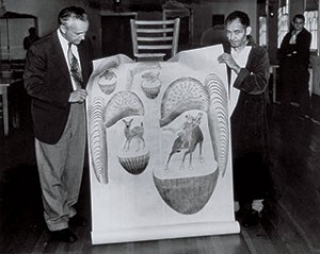Born 1895, Tepatitlán, Jalisco, Mexico
Died 1963, Auburn, California
Recurring motifs in Martín Ramírez’s intricate drawings—equestrians brandishing pistols, the Virgin of the Immaculate Conception, cypress trees, deer, and livestock—evoke the landscape and culture of his native Mexico. Ramírez was born in the region of Los Altos de Jalisco, a devoutly Catholic agricultural community. Though his parents were farm laborers, Ramírez became a ranchero with his own plot of land near the town of San José de Gracia. In 1925 he emigrated to the US to work on the California railway, another subject frequently portrayed in his drawings. The outbreak of the Cristero War in 1927 prevented his return to Mexico, and the Great Depression left him jobless and homeless. Arrested in 1931 for unclear reasons, Ramírez was subsequently committed to the Stockton State Hospital and diagnosed as schizophrenic. In 1948 he was transferred to DeWitt State Hospital near Sacramento, where he created the 450 drawings that comprise his known body of work.
The figures, animals, and locomotives in Ramírez’s drawings inhabit otherworldly landscapes and structures, rendered with continuous rows of parallel lines and curves (p. 128). His unconventional approach to perspective, in which striated forms seem simultaneously to recede into and project outward from the picture plane, creates a sense of space that vibrates and folds in on itself. The strong visual appeal of Ramírez’s radiating linear patterns is matched by the heightened tactility of his materials. Pasted together from discarded nurses’ notes and other scavenged paper, the surfaces of his drawings have rough textures that are enhanced by his encaustic-like medium of melted crayons mixed with watercolor—a physical analogue to the virtual ridges and valleys depicted.
Tarmo Pasto, a psychology professor at Sacramento State College, discovered Ramírez while researching art of the mentally ill at DeWitt in the early 1950s and exhibited his work as “schizophrenic art.” In 1968 artist Jim Nutt encountered Ramírez’s drawings among Pasto’s course materials while teaching at Sacramento State and was impressed by the vivid world they delineate. Together with art dealer Phyllis Kind, Nutt purchased from Pasto a cache of three hundred drawings. Kind’s later exhibitions of Ramírez’s work established its aesthetic and commercial value, recontextualizing it within the burgeoning field of “outsider art.”
Antonia Pocock
Anderson, Brooke Davis. Martín Ramírez. New York: American Folk Art Museum, with Marquand Books, Seattle, 2007.
Cooke, Lynne, ed. Martín Ramírez: Reframing Confinement. Madrid: Museo Nacional Centro de Arte Reina Sofia, 2010.
Espinosa, Víctor M. Martín Ramírez: Framing His Life and Art. Austin: University of Texas Press, 2015.
